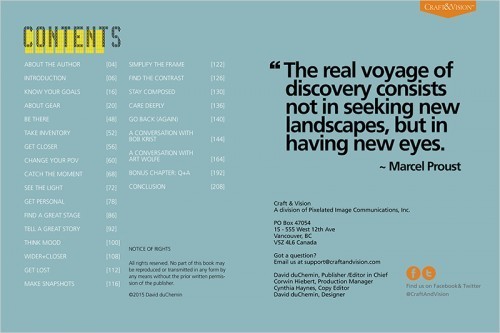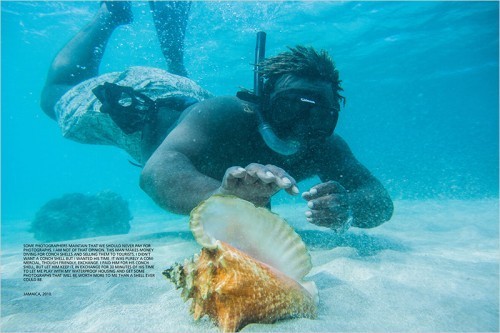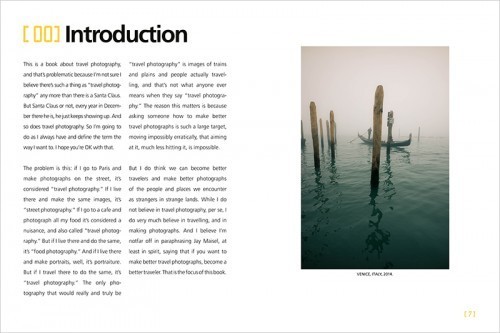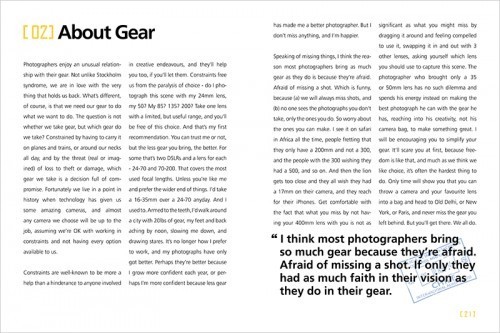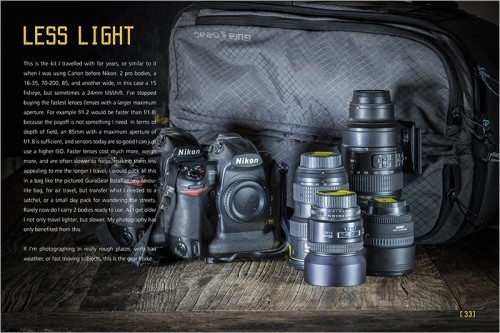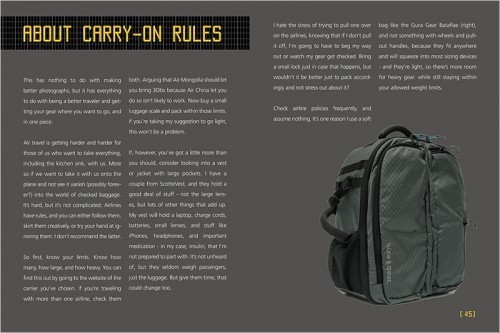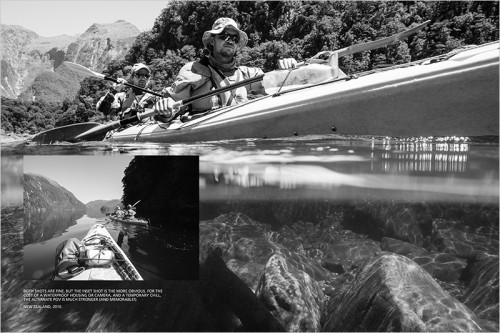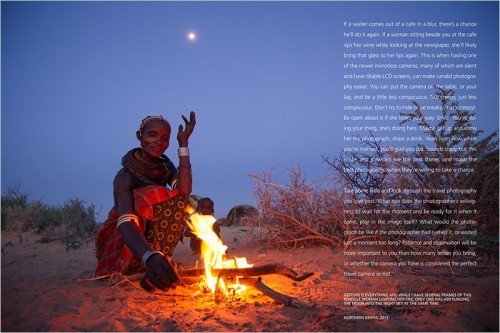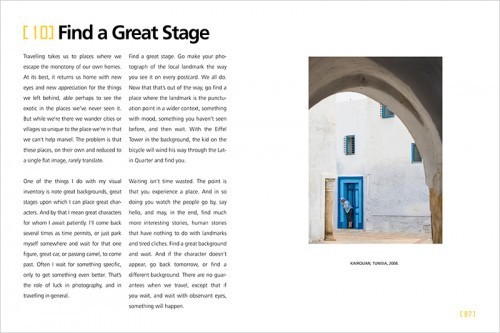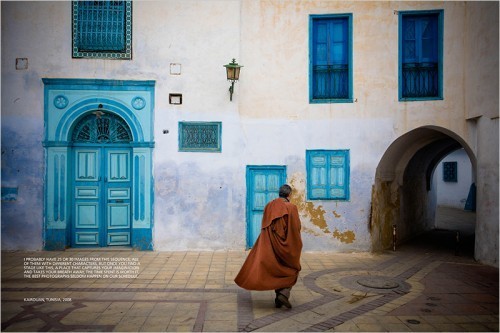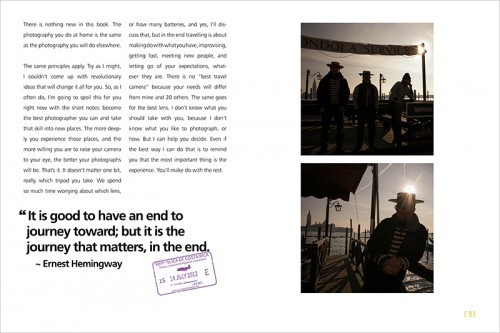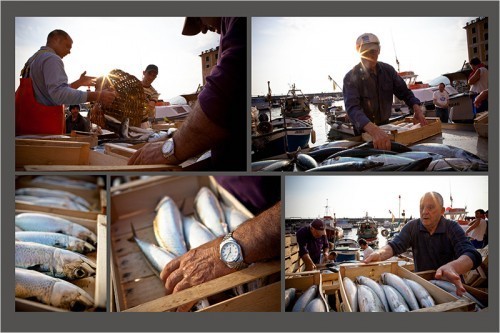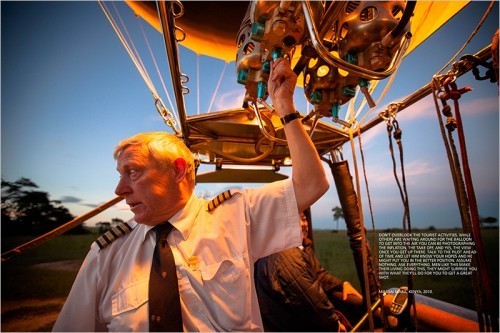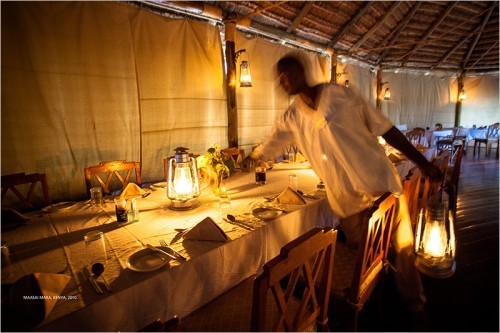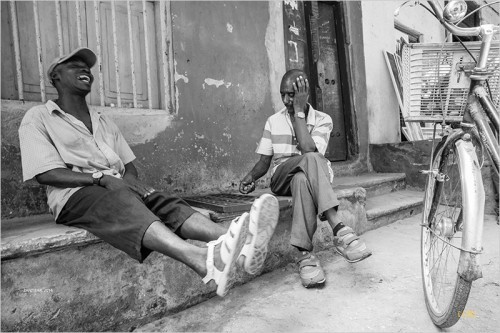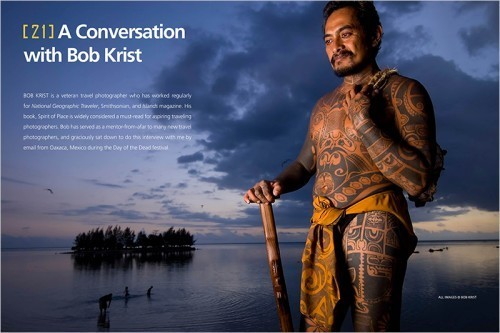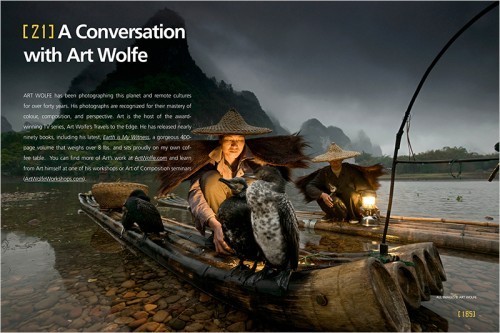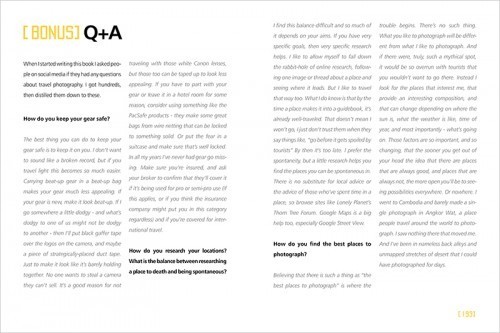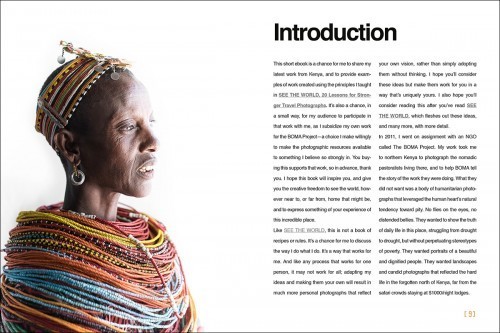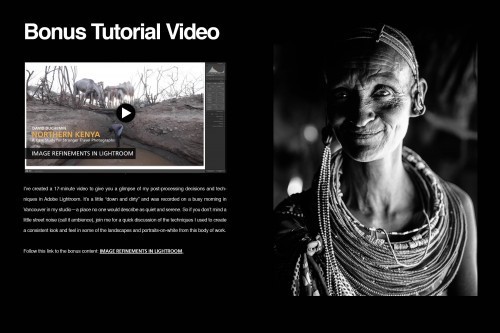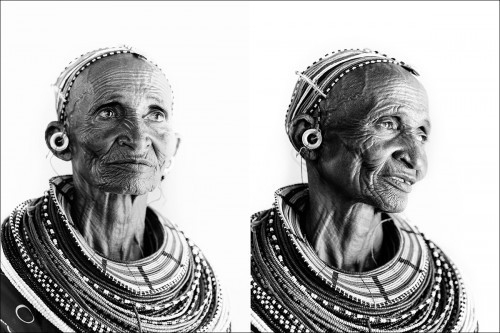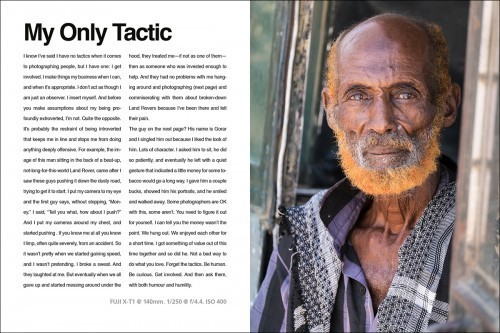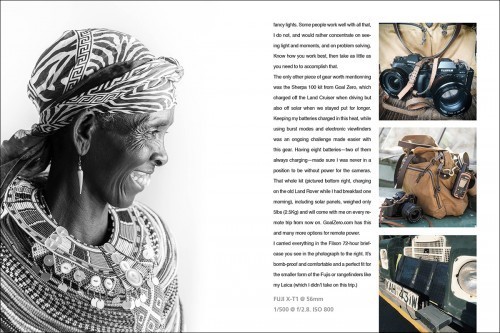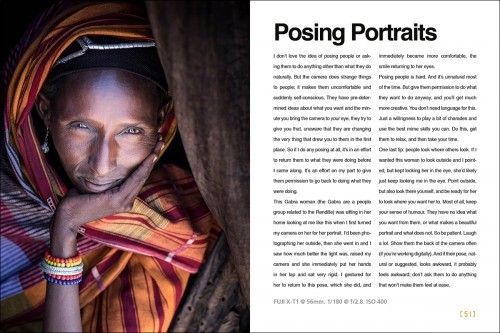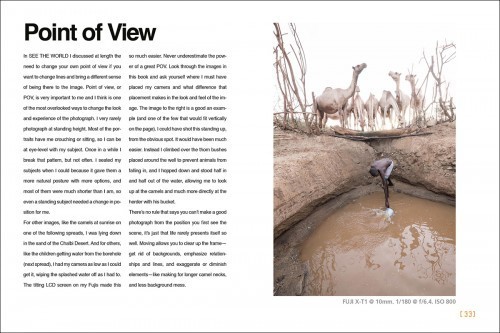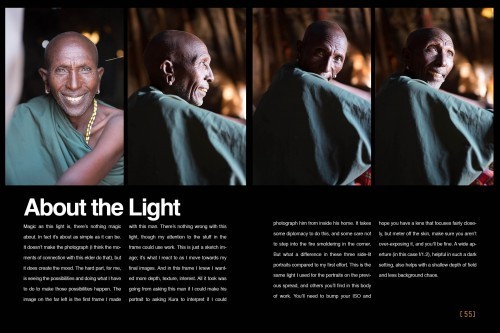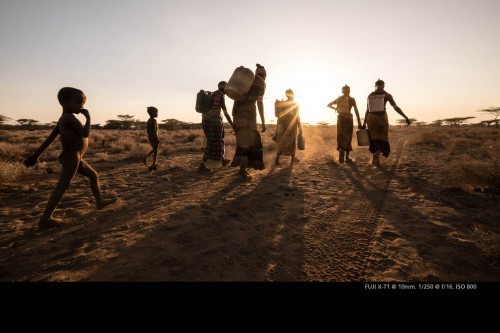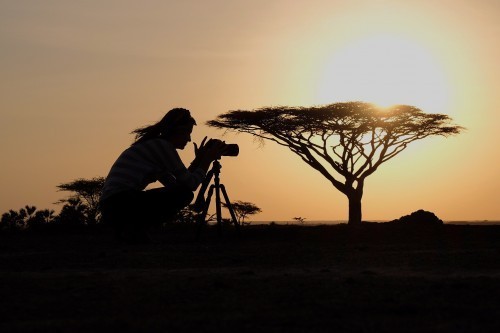David duChemin's Blog, page 18
March 26, 2015
Visualize Spots
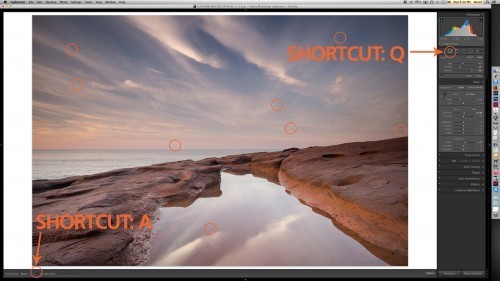
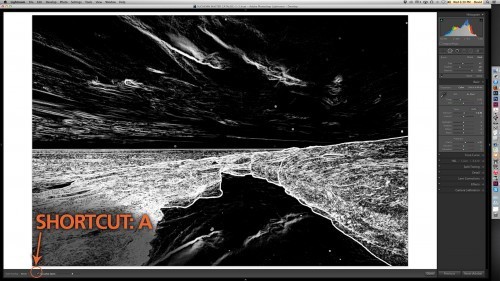 This is a bit of a quickie, but I only just learned it myself. It’s two tips in one. If you don’t already know, there’s a way to visualize the dust spots on your image when using the Spot Removal Tool in Lightroom. Not surprisingly, it’s called Visualize Spots and you can click the little box in the lower left to toggle it on and off. That’s Tip #1.
This is a bit of a quickie, but I only just learned it myself. It’s two tips in one. If you don’t already know, there’s a way to visualize the dust spots on your image when using the Spot Removal Tool in Lightroom. Not surprisingly, it’s called Visualize Spots and you can click the little box in the lower left to toggle it on and off. That’s Tip #1.
The view you get once toggled is the bottom image above (click either image to make them larger). Makes it much easier to see what you’ve missed. However, it drives me mad to have to move the mouse from what I’m doing to check that little box on and off (because sometimes Lightroom’s efforts to heal a spot remind me of Cookie Monster eating a cookie – heavy-handed and less than subtle). Until now I’ve grumbled that there should be a shortcut to toggle this, but I didn’t let my mouse linger long enough for the shortcut to present itself. And then I stopped being so lazy about finding shortcuts to support my laziness, and I went looking for it. And for those that don’t know it – this is Tip #2 – the keyboard shortcut is A. Q for the Spot Removal Tool, A for the Visualize Spots Toggle.
Or you could clean your sensor, but there’s no keyboard shortcut for that.
*Don’t forget you can also sync the changes you make across multiple photographs, or just copy/paste the Develop settings and select only Spot Removal to remove spots on many images at once – but I have never found this works for anything but images that are exactly the same. This is one of those instances where not taking the shortcut usually works best for me.
March 24, 2015
Forget Practice
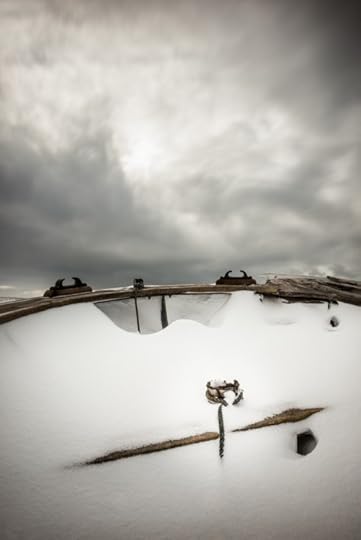 Boat under Snow. Hokkaido, Japan. 2015.
Boat under Snow. Hokkaido, Japan. 2015.
Yesterday I linked my social media accounts out to an old blog post – Toward Mastery. One of the replies I got was refreshingly honest: I’ve hit a brick wall, and no amount of practicing is working. Twitter isn’t the kind of place to reply meaningfully to that kind of candor, so if you’ll indulge me, I’ll do it here. I know there are a lot of you out there that need to hear it. I’ve met you. Talked to you. I’ve been you, and most days, I’m still you.
First of all, you’re wrong on the most basic level, because I’ve seen your work and there’s some really great stuff in there. It’s consistent. It’s alive. There’s an energy there, and I’d look at those images any day. So it might be that you need to ask yourself what you even mean by, “it’s not working.” What are you hoping to achieve? What is your photography not doing for you that you want it to? It might have nothing to do with practice. You might already be there. You might have already honed your craft to the point that practice is not what you need any more.
Maybe you need to venture out into new directions? Maybe what you are shooting is your safe place now and there’s no risk anymore, and you need to do something new, something scary. Maybe you need to impose some creative constraints so you have something new against which to strain – a little like building muscle, our creativity grows only as we encounter resistance. Perhaps you need to play more, and take yourself less seriously? Perhaps you need to find someone to collaborate with.
Practice, forgive me for flailing so unkindly at a sacred cow, is not the be-all, end-all. When it is suggested that our first 10,000 images are our worst, I suspect strongly that creating them, looking at them, and reacting to them, playfully and without losing the joy of creation and discovery, is much, much, more important than practice -which to me seems to suggest repetition, not play. Repetition makes permanent, but it’s no way to spend our lives. The muse gets bored quickly.
The only wall you’ve run into is one that you’ve created yourself, and you’re not being remotely as creative in getting around, over over, this wall, as you were when you created the photographs I’m looking at now, on your Flickr stream. Ask yourself: what do you want, creatively? If what you’re doing now isn’t it, then abandon it. Try something else. But like so many others I talk to, could it be that you’re just wrestling with the great discontent of being a creative person? I mean, don’t we all wrestle with the longing for our work to be better, to more powerfully express the ineffable things we’ll probably spend our entire lives trying to say? To eff the ineffable, as Nick Hornby once wrote. That’s the challenge. It’s not the obstacle, it’s the path. Find a way to enjoy that tension, to use it to push you forward, and to look at the work you’ve done and love it for what it is, or was – something you thrilled to make, something imperfect that is, all the same, part of you, and a gift to the rest of us. Lying face down on the cobbles is likely to make any road look like a brick wall. Stand up and start walking, it’ll become a path again. It always does.
March 23, 2015
Saw & Mitre Giveaway
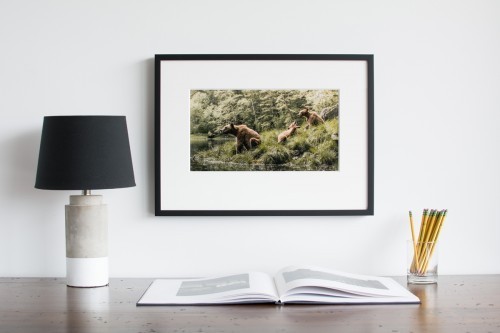
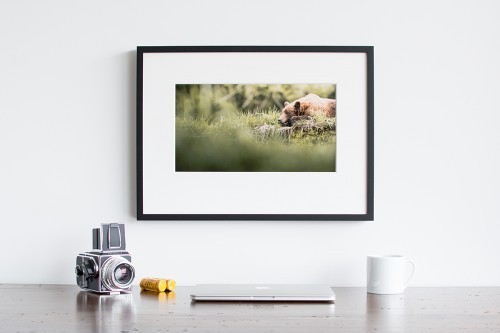 Most of you know how important I think it is to print your work, to hold it, to live with it, and to give it away. Part of that is framing your photographs and giving them the place of attention and honour your craft and vision deserve. I have a lot of frames, but hands-down the nicest ones, made with the same kind of care with which I make my photographs, have come from Saw & Mitre. I love what they do, who they are, and what they’re about. So when they asked me if they could give away a couple of my prints in their frames, I jumped on it. I have two prints to give away – one here on the blog and the other on my Instagram account. Just leave a comment here (or on my IG account if you follow me, or do both!) and you’ll be entered to win. The blog winner gets the image at the top of this post, the IG winner gets the one below that.
Most of you know how important I think it is to print your work, to hold it, to live with it, and to give it away. Part of that is framing your photographs and giving them the place of attention and honour your craft and vision deserve. I have a lot of frames, but hands-down the nicest ones, made with the same kind of care with which I make my photographs, have come from Saw & Mitre. I love what they do, who they are, and what they’re about. So when they asked me if they could give away a couple of my prints in their frames, I jumped on it. I have two prints to give away – one here on the blog and the other on my Instagram account. Just leave a comment here (or on my IG account if you follow me, or do both!) and you’ll be entered to win. The blog winner gets the image at the top of this post, the IG winner gets the one below that.
There’s one catch – because of shipping prices, the winner has to be from Canada or USA. Sorry. I know that stings, but sometimes, Disney be dammed, it’s not such a small world after all, and shipping is crazy expensive on things like this.
For those of you who don’t win, but like the look of what Saw & Mitre offers, here is a discount code for 10% off everything on the site and it’s good through April 15: sawandmitre10
Huge thanks to Saw & Mitre for being so generous with this one. Make sure you check them out at SawAndMitre.com and follow them on Instagram – they frequently run giveaways in collaboration with some really great photographers.
Just leave a comment – no need for much more than “I’m in!” – and make sure we have your email address in the right field. I’ll do the draw in a week. Again, with apologies to my global friends, this one’s Canada and USA only.
March 17, 2015
Northern Kenya: A Case Study
 Two weeks ago I returned from assignment work in northern Kenya. You’ve seen some of the work already. It’s by far my favourite work, done for my favourite organization – the Boma Project. In fact I like them so much that after my first assignment with them I became a donor, and committed to making my services part of that donation.
Two weeks ago I returned from assignment work in northern Kenya. You’ve seen some of the work already. It’s by far my favourite work, done for my favourite organization – the Boma Project. In fact I like them so much that after my first assignment with them I became a donor, and committed to making my services part of that donation.
Today I’m giving you a chance to participate in that with me, and to be among the first to see my fuller body of work. It won’t surprise you to learn I’ve put together an 80-page eBook with over 40 images from this recent trip, and in that context have continued the conversation about stronger travel photographs that I started in my last eBook, See The World. There’s also an included 17-minute video (the download link is in the book) that walks you through some of my post-production techniques in Lightroom. And while I’ve priced it at $7, I’m giving regular readers the chance to get it for $5 before March 26 (or you can get it with See The World, for only $24 – check out the bundle).
We won’t be hitting the hard-sell button on this, just letting regular readers know there’s a chance to learn, be inspired, see more of this work than others will for a while, and to help along the way – the profits help pay for this work, and help us commit to the next assignment with the Boma Project, working with women and children in some of the roughest, and poorest, places on the planet.
Northern Kenya, A Case Study for Stronger Travel Photographs is available today for only $5.
March 15, 2015
Hungry?
“When your hands are full of thorns but you can’t quit groping for the rose…” ~Bruce Cockburn.
I feel myself getting hungry. Or perhaps I’m always hungry but only now recognizing that gnawing feeling for what it is. I get that way when I come out of a time of gorging myself creatively, as I have recently in Kenya. I come back to the emails and Facebook and blogging, and client needs, and eBooks, and the camera sits. The hunger is to create new work, work that opens me to new experiences, and gives me the deep soul-satisfaction of having created something, told a story, touched someone somewhere. You and I aren’t so different, you know. Most of my readers, regardless of whether they make money with photography or not, are rabid amateurs – they do this for the love of it, for the thrill of the chase. And so when you email me, or drop a comment, and it echoes with your longings and your frustrations, I get it.
But here’s the thing, most of those comments seem to want me to give some advice that will help stop the frustration, which is the same thing as extinguishing a fire I’m trying really hard to keep ignited. Sure, you get burned once in a while if you sit too close – but don’t be so hasty to put out the flames that you forget the deep cold we risk when we give up and sit too far from the fire. And no one that cares – and I do – will extinguish that fire for you. And that’s the only way to quench the frustration and satiate the hunger.
The only thing is to allow the hunger. Feed it. Find a way to cherish the growling in the belly when its been a while since you’ve eaten. We do that with new experiences, and personal projects, and never resting on the laurels that we make of our past work and Facebook likes. We do it by changing our perspective on what it means to succeed at all this, and to chase the right things, the things that we will one day look back on with pride and satisfaction, the things worth failing at the first few times. I doubt my generation will be as proud of their Twitter feed as they will be of work the work that they now hunger for.
Don’t you dare disparage the longing for something more, and the effort to get there. Don’t settle. Don’t tire of reaching for the flame. Don’t get lazy, and don’t feel guilty when you do – that’s just more energy preventing you from picking up the camera, the pen, the paintbrush.
“I doubt my generation will be as proud of their Twitter feed as they will be of work the work that they now hunger for.”
The thing about hunger is there is always more than one way to feed it. And since so many of you do embrace the idea that mastery is a journey and the learning is never complete, I want to say one more thing. It’s a Sunday morning, and this is my homily, so bear with me.
“And beginning is what matters. Doing. Making. Trying. Risking. Falling. Trying again. That’s where the real learning happens.”
I’ve noticed something about photographic education, a fork in the road that doesn’t get discussed, and I want to encourage you to consider taking the road less traveled, not because Robert Frost has a thing to say about it, but because I think one path is the better one.
The prevalent path throws junk food at our hunger – a new tip, a new piece of gear, a new technique. Once I learn those things, those magic missing things, only then will I get over my fear and do my work. Only then will I know what I need to know. It’s a path that circles around a lot. It doesn’t really go anywhere.
The other path recognizes that we learn best while we do. It’s got fewer people on it, winds here and there, and once in a while it circles back, but it feeds the hunger with things that grow the soul and put wood on the fire (if the metaphors weren’t mixed before, I think I’ve just thrown them into a blender). That second path acknowledges that the learning never stops and if we wait to graduate before we do our best work – also a journey – we’ll never begin. And beginning is what matters. Doing. Making. Trying. Risking. Falling. Trying again. That’s where the real learning happens. You want easy? Take up stamp collecting.
The hunger is fed when we do our work. And its presence – always there, always gnawing, even in the middle of work that we’re doing right now – is a good thing. Listen to it. But be intentional about how you feed it. And if you’ve read this whole thing wondering why you don’t feel the hunger at all, and you long for it all the same, then that too is a hunger of sorts. Feed it. Begin. It’ll come back. Try a new direction, follow your curiosity, tell some new stories. The inspiration comes from working. The learning comes from failing. Do that.
March 10, 2015
Q+A: Fuji X on Assignment
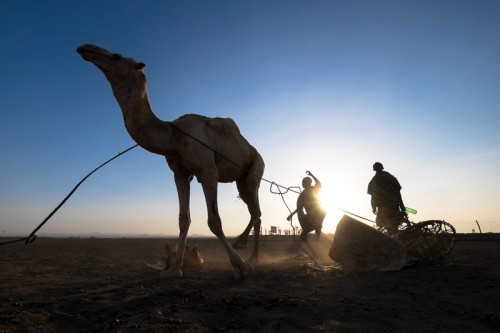 You’d be amazed how many emails and comments I get that begin with the words, “I know you don’t like gear questions, but…” So to be clear, I don’t mind gear questions at all. I just don’t know why people think I’m the best person to answer them. I like gear. Hell, I LOVE some of my gear. But I ask of it some very specific, and limited things, and some of the people asking some of the questions are looking for a tool that can do the things that they themselves should be doing. Or maybe they’re looking for a justification to buy a new toy that maybe, just maybe, has the Un-Suck Filter. They don’t. My Fujis don’t, and neither do my Leicas or Nikons. What I want my cameras to do is get out of the way as quickly as possible and let me do my job. So with that in mind, a few responses to some very sensible questions (I’ll spare you the non-sensical questions like: Should I get a Fuji? No one can answer that for you. Fuji. Leica. Nikon. Canon. All of them will make incredible photographs as easily as truly bad ones.)
You’d be amazed how many emails and comments I get that begin with the words, “I know you don’t like gear questions, but…” So to be clear, I don’t mind gear questions at all. I just don’t know why people think I’m the best person to answer them. I like gear. Hell, I LOVE some of my gear. But I ask of it some very specific, and limited things, and some of the people asking some of the questions are looking for a tool that can do the things that they themselves should be doing. Or maybe they’re looking for a justification to buy a new toy that maybe, just maybe, has the Un-Suck Filter. They don’t. My Fujis don’t, and neither do my Leicas or Nikons. What I want my cameras to do is get out of the way as quickly as possible and let me do my job. So with that in mind, a few responses to some very sensible questions (I’ll spare you the non-sensical questions like: Should I get a Fuji? No one can answer that for you. Fuji. Leica. Nikon. Canon. All of them will make incredible photographs as easily as truly bad ones.) Why Didn’t I take my Leica M?
Why Didn’t I take my Leica M?
I love my Leica M(240). I adore it. But it’s fully manual and doesn’t do as well in really low-light / high ISO. I find it hard to focus quickly in those conditions. Blame it on my eyes. So knowing I’d be in some fairly fluid circumstances, and making portraits in dark huts, I wanted autofocus. And I wanted to bring only one system, because charging my Fuji batteries would be challenge enough, nevermind charging batteries for 2 systems.
Why take the 56/1.2?
I took a 10-24mm, 56mm, and 55-200mm. So why the 56/1.2? A few reasons. First, it’s several needed stops brighter than the 55-200 and I knew I’d already be shooting at high ISOs at times. Second, the 55-200 isn’t great with lens flare. Third, even in lighter portrait situations it’s a nicer portrait background at /1.2. And really, it’s easier to use, faster to focus, and smaller to carry. The 55-200 came out for distance stuff – shooting camels against sunrises, and isolating landscapes. When I do it again I’ll bring another lens, a 35mm, to bridge the 24mm – 55mm range because the huts are really tight and there were times the 56 was too long. 24 was too wide and not terribly flattering for the kind of portraits I wanted to do. 35 would be perfect.
What about the RAW files?
I keep hearing people asking me what I think about the RAW processing of Fuji files in Lightroom. Honestly, I’m not a pixel-peeper, and I haven’t noticed an issue with the processing. You have to choose the tool that works for you and if you don’t like the look of the files, try a different convertor or use a different camera. I’ve never been unhappy with the look of my photographs, and no one’s ever taken me aside and told me they’d look better if (a) I wasn’t using Fuji and/or (b) I used something other than Lightroom. For me it’s a non-issue. (If you’re looking for some interesting information on sharpening for the Trans-X sensor, here’s something from Pete Bridgwood that I thought was worth the time.)
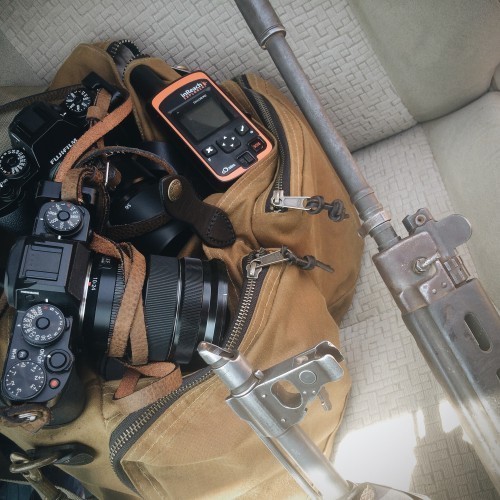 When your security goes for chai.
When your security goes for chai.
Were they fast enough?
The Fujis were really great. When they failed to focus it was mostly because changing the focus point on these cameras is quirky, and – to be frank – more of a pain in the ass than it should be. Are you listening, Fuji? Make the damn buttons more tactile or something. But you get used to tools and their quirks and for the most part I got the shots I aimed at. The high-speed burst mode was really responsive and I rarely had to wait for the buffer to create space. But I was doing mostly landscapes and portraits and only a few faster situations, like dancing. For me, the X-T1 bodies were surprisingly responsive.
What about the weather sealing?
I never took the 10-24mm off the camera, and the 56 got switched out maybe a couple times a day with the longer lens. I noticed very little dust. Water wasn’t an issue, but the dust in this desert region was insane and I had no issues I’ve noticed. I make it a practice in places like this to put each body into a Buff (a fabric sleeve you can pull over your head, use as a bandana), then wrap the strap around that, creating a little more protection in the bag, but I don’t baby my stuff and other than a wipe now and then I just trusted them to handle the elements.
Is it “Pro-Quality”
I don’t even know what that means. These cameras did the job I needed them to do. Just like some “pros” still use a 30-year old Nikon film camera or 80-year old 4×5. For some pro work it’ll do perfectly, for others, not so much. But that is true of every camera you can buy. A “pro” quality camera doesn’t create “pro” quality images; it creates images of the quality of the user. End of story. Know your needs. Get the camera that does that.
Will you do it again?
Absolutely. I love these cameras. My sweet spot for image size would be 24mp, and the Fuji gives me 16mp but the quality is excellent. They’re light. The ergonomics mostly work for me ( I love manual dials), and other than the need to carry a few more batteries (bright LCD, high speed bursts, shooting all day) than you think you’ll need ( I carried 8 and used them all at times), there are few reasons I can think of not to keep using the Fujis. I just got a waterproof housing from Nauticam and will be using the X-T1 for diving as well.
Got any other questions that might be helpful? Leave them in the comments and I’ll do what I can to respond. But if you want really techy stuff, you might want to try DPReview or something similarly supportive of the geek/nerd agenda 
March 6, 2015
Kenya: Tech on the Road
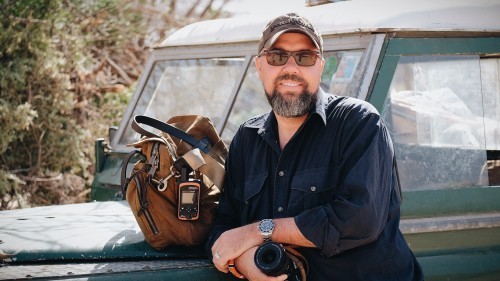
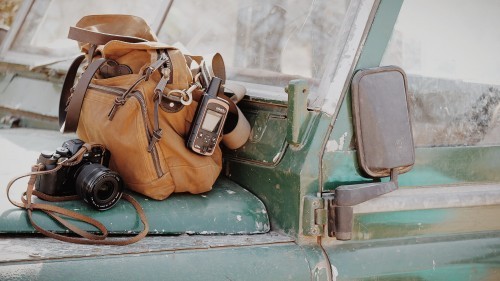 There were two pieces of tech, cameras aside (and I’ll talk about them in a separate post), that made my work in Kenya last month possible: one was the Goal Zero Sherpa 100, the other was the DeLorme InReach, a satellite communicator.
There were two pieces of tech, cameras aside (and I’ll talk about them in a separate post), that made my work in Kenya last month possible: one was the Goal Zero Sherpa 100, the other was the DeLorme InReach, a satellite communicator.
Power has been an issue on past trips, and this time I picked up an option that will go with me on similar trips from now on. Already a fan of Goal Zero (I have two of their larger battery packs, which are heavier and more powerful than I needed for this trip) I picked up a Sherpa 100 kit with a 100w battery pack, folding solar panels, and cables that would allow me to charge this pack with solar (no shortage of hot, bright sun in northern Kenya), or from a wall (helpful before and after the trip, but not a chance of from-the-wall power on this trip), or from the 12v of the truck as we drove.
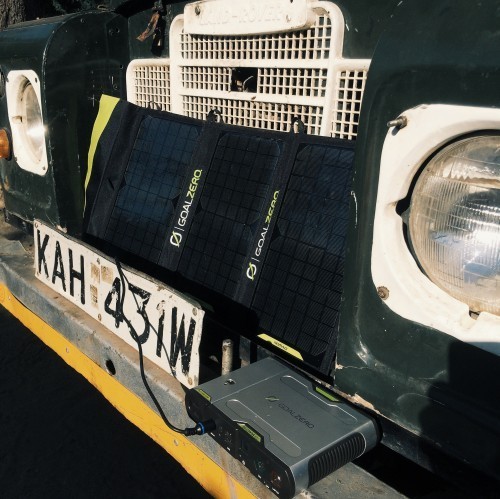 Taking advantage of an old Land Rover to get some charge time during a break.
Taking advantage of an old Land Rover to get some charge time during a break.
The kit weighs about 5lbs, has 2 outs for USB, a 110v inverter, and, if you don’t use a Mac, an out for a laptop. Using solar it took about 8 hours to fully charge, and that charge would do iPhones, and several camera batteries, as well as most of a laptop charge. Bring 2 sets of solar panels, daisy chain them, and the charging time would go down, I assume, by a half. In a year I’m shooting an assignment in Lesotho and it’ll be equally remote. I’ll be bringing two of the Sherpa 100 battery packs and 2 of the panels. If you work remotely, and need to recharge batteries, take a look at the whole Goal Zero line. Excellent products and good support. Each time I’ve called they’ve been really responsive.
The second itch I wanted to scratch was communications with home. I carry an Iridium satellite phone, but it has two disadvantages – it’s expensive and it’s frustrating enough to make me want to pitch it into the nearest river once in a while. So when I saw my friend John Marriott using a DeLorme inReach Explorer at Cape Churchill this year, I was pretty sure I’d found my solution. 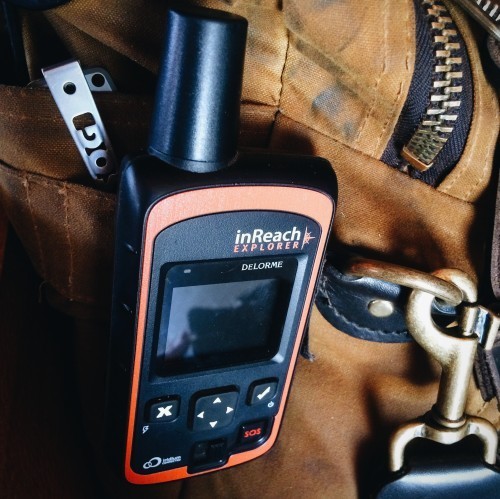 My inReach Explorer was with me at all times, kept track of movements, elevation, and – importantly – kept me in touch with home so far away.
My inReach Explorer was with me at all times, kept track of movements, elevation, and – importantly – kept me in touch with home so far away.
The inReach pairs with my iPhone (ipad or iphone, Android too, I believe) and allows me, through an app, to easily type out 160-character texts to mobile numbers, email addresses, and even Facebook and Twitter, and with that goes my GPS coordinates so friends can see where I am. I also gave my family a password-protected link and they could log on, to my DeLorme site, see where I was at any time, and send messages from their browser (or they can repy to the email or SMS on their phone, etc). I don’t need the iPhone, it works on it’s own, though it takes longer to type a message, choosing one letter at a time, and the battery seems to do quite well. Being well out of network range for most of the trip (and even when I was it was costly) the inReach allowed me to stay in touch with home, post to FB a couple times (text only) and return to a complete track of my journey on my page of the DeLorme site.
We had a couple days of a weird service outage, but other than that it worked really well and it’ll be in my bag, or my Jeep, on future adventures. You can buy the inReach Explorer at places like Canada’s MEC, or on Amazon, and activate it from home, choosing one of a few reasonable service plans, and those plans can be put on hold for something like $5/month if there are stretches of time you don’t plan to travel. Lastly, there’s an SOS button that calls in the calvary. You’ll be pleased to know that I had no reason to test it this time.
March 4, 2015
Northern Kenya, Pt. 1
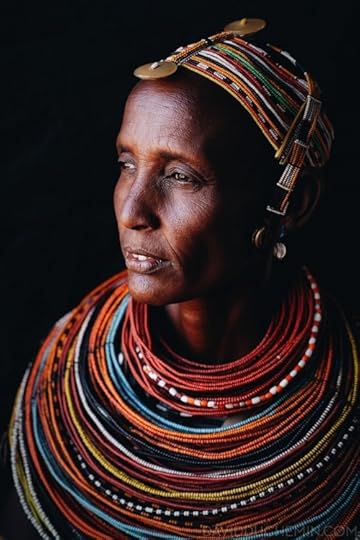
The black road leading towards the dust-shrouded sun is warming,
Flanked by a thousand citizens walking to work,
to school,
to anywhere but here.
Nairobi wakes to birds and dogs and the honking horns of every car and bus
That soon will choke these roads.
And we, today, head-fogged and time-lost from half a world away,
Are heading north, half-drunk on jet lag, dust, and diesel,
And the memories of friends to whom we now return.
The road to that reunion takes us past mango trees ripe with fruit
And acacias hung heavy with the nests of weaver birds
And everywhere the soil is red and stains what it touches,
Indelible like Africa herself on my soul.
And every couple miles there are rows of market stalls,
Cobbled together by necessity, sticks, and twine,
And huddled-about by laughing women who would just as soon giggle
And gossip, as sell you the mangoes they’ve piled high
Like the bicycles that labour past, so laden with goods,
Chickens, charcoal, a hundred yellow water jugs,
Balanced impossibly by riders who’ve done this so often
They’ve long forgotten the physics that elsewhere would forbid this.
School kids litter the sides of the road with colour,
Their bright uniforms changing every few kilometres,
Their ranks broken now and then as a boy chases a goat,
A donkey, or some long-suffering and much-too-ribbed cow.
Everything is in motion, a swirl of colour, against the muted dust.
Days later that colour is in in the beads of the Rendille,
The pounding, leaping dance of the Gabra women,
and the once-Scottish plaid of warriors driving their camels.
Our nights are spent under endless starry skies,
The only lights for a thousand miles from the fires of herders
Who sit under a blanket of darkness pierced by the holes in the floor of heaven
And wait for the God that walks those floors to spill some water
On this too-dry land.
__
Over the next couple weeks I’ll talk about the assignment in northern Kenya from which I’m still returning. Almost two weeks in the heat and dust of the Chalbi desert, the cedars of Mount Kulal, and the dark, smokey huts of the nomadic pastoralists I’ve visited and photographed in this region for the last 5 years, all of them wrestling with a changing climate, tightening drought cycles, in an already forbidding place.
The work I was doing was for the BOMA Project, a group working to empower women among nomadic pastoralists in northern Kenya. These women they work with are beautiful, enduring women, and they bring to mind and heart, when I can’t be with them, my own beautiful, enduring women – my mother and Cynthia. It’s work I adore, with people I come close at times to revering, and I can’t wait to unpack a little of it for you. There were so many times, driving the 2500 km we put on the vehicles, that I remember saying, I have the best job in the world; we should all be so lucky to do work we love so much. Still, it’s good to be heading home.
It’ll take a while to download and process the images (8 x 64GB, God help me!) and get them to the client, which is the first priority, but while the computer in the studio grinds away I’ll drop images into Instagram, post a few blog posts, and try to make up for my absence.
February 14, 2015
To Africa with the Fuji X-T1
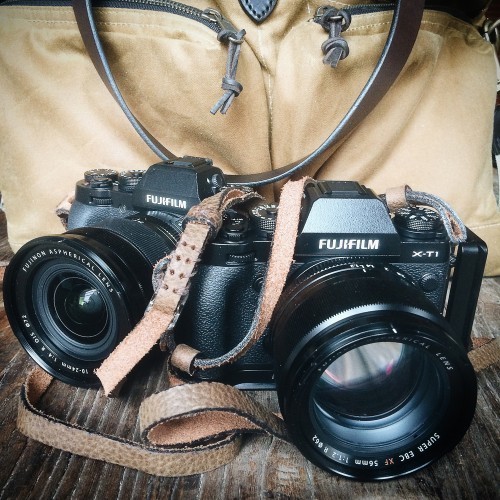 Two Fuji X-T1s and lenses for this trip to Kenya. The bag is one of my carry-ons, a briefcase from Filson
Two Fuji X-T1s and lenses for this trip to Kenya. The bag is one of my carry-ons, a briefcase from Filson
My conversion to, and love affair with, smaller cameras is about as complete as it can be now. If the social media I’m reading is to be believed, it’s complete for many others as well. Photographers seem to be jettisoning their heavy DSLR gear in favour of smaller mirror-less cameras, and while I doubted I’d be doing so as quickly, when I get on the plane to Kenya for two weeks of assignment work tomorrow, I won’t be taking a DSLR.
My transition has been slow. I took my Fuji X-E1 to Italy 2 years ago, but I was teaching and not worried about the consequences of coming home without the images I expected and having fallen out of love with the Fuji. That, of course, didn’t happen, and there was so much I loved about it, not just the images it gave me but the way it lightened my load. Then I went to Ethiopia and Kenya, and took my Leica M(240) and the same X-E1, and that put the final nails in the coffin; so impressed was I with the performance of those two cameras I decided my days traveling with my DLSR gear for this kind of trip were over.
Of course I haven’t sold my Nikon gear. It just spends more time than it once did in its Pelican cases. I’ll use it for now when I need the long lenses for wildlife, or if I need the file size of the D800, but it won’t soon be doing travel, street, cultural, or landscape work, which is the bulk of what I do. And with the newer Fuji X-T1, which I was so impressed with, I bought two, and the new dive housing from Nauticam, I can use my mirror-less cameras underwater.
My bag going to Kenya has two X-T1 bodies, and 3 lenses: a 10-24mm, 56/1.2, and 55-200. Each body has a Really Right Stuff L-plate. And I’ve got 4 batteries for each (small batteries don’t last as long using these EVF cameras, so take a few), and eight 64gb cards. That kit, along with cleaning gear, my 11″ MacBook Air, and assorted bits and pieces, like the DeLorme inReach Explorer I’m hoping to use to map and share my journey, all fit into a very small Think Tank Photo Airport Essentials bag with room to spare.
Cameras by other brands have similar benefits, but I only know the Fuji, and here’s what I love about the X-T1, especially. It’s light and small, you know that. The focus is getting much faster and as I don’t photograph sports, it’s now as fast as I need it for this kind of work. The weather-sealed body is tough. The EVF (electronic viewfinder) is so useful I don’t know what I did without it, and the flip out screen is brilliant for waist-level, or over-the-head work. The wifi functionality is excellent and makes it easy to upload photographs to my iPhone or iPad mini, make some tweaks and be showing the client in the front seat of the Land Rover before we’re at our next location. The ergonomics are solid and the manual dials for ISO and shutter speed mean I can shoot even faster because even after all these years, the muscle memory for dials is more easily recalled than it is for the buttons that move here and there with every new camera. Aside from my Leica M, this camera gets out of the way faster than any camera I’ve owned since the Pentax Spotmatic 35mm I had when I was a teenager. And on top of all that the image quality is excellent, it blows me away every time. As good as the Leica I love so much, not quite, no, but for 1/4 of the price, it’s a hell of a deal.
I’ve got a couple more things to throw into the duffle bags and I’m on a flight tomorrow. I’ll check in as I can, but it could be a week or two, the locations for this assignment are some of the most remote I’m ever in. I’ll update Facebook and Twitter with some waypoints and text updates from the inReach Explorer.
Excited about traveling with smaller mirrorless cameras? You’ve got a few more days to get my latest eBook, SEE THE WORLD, 20 Lessons for Better Travel Photographs, for only $15 and at the same time be entered automatically to win a new Fuji X-E2 and 18-55mm lens. We’ll be sending this great little camera to one randomly chosen reader as soon as I get back from Kenya on March 03 or so.
February 10, 2015
SEE THE WORLD For $15, Win a Fuji*

Today we’re releasing a book we’ve been planning for a long while. It’s a book about travel photography that just never happened, until now, because I was busy traveling. But today it’s out and if you buy it this week, before February 19, 2015, you can save 25% on it, and be entered to win a Fuji X-E2, one of my favourite cameras, and an 18-55mm lens. We all create differently, but I could travel the world with this one camera and lens and be very happy. It’s about as close to the ideal travel kit as I’ve seen, and I’d love to send you off on your adventures with one.
The best photographs from around the world have so little to do with which camera was used, or how compact the tripod was. They have everything to do with the photographer you bring with you. This is an investment in that photographer. Sure, I talk about some of the issues of traveling, stuff like which cameras I take, and how I deal with carry-on luggage restrictions, and yes, I include packing lists and discussions about tripods and bags, but that’s just the trivial stuff. The important stuff comes in the form of 20 lessons designed to teach you what I believe is the real art of traveling with a camera while experiencing new places, landscapes, and cultures. Stuff like storytelling and finding elements of the visual language that help you tell those stories; about dealing with people, and working through the creative process of seeing places for the first time.
“The best photographs from around the world have so little to do with which camera was used, or how compact the tripod was. They have everything to do with the photographer you bring with you. This is an investment in that photographer.”
The book is available only in digital format as a PDF. It’s almost 210 pages, and includes interviews with Bob Krist and Art Wolfe, both veteran photographers who’ve traveled the world for their whole careers. Until the end of February 18 it’s only $15. *Everyone that buys SEE THE WORLD before February 19, 2015 gets entered for a chance to win a new Fuji X-E2 and 18-55mm lens. (I’ll be in Kenya on assignment during that time, so the draw will be made, and the winner announced, when I get home at the beginning of March)
